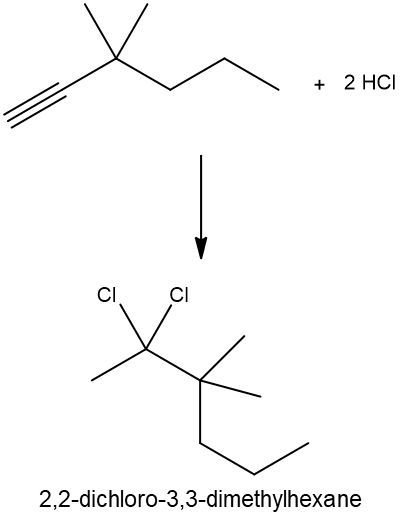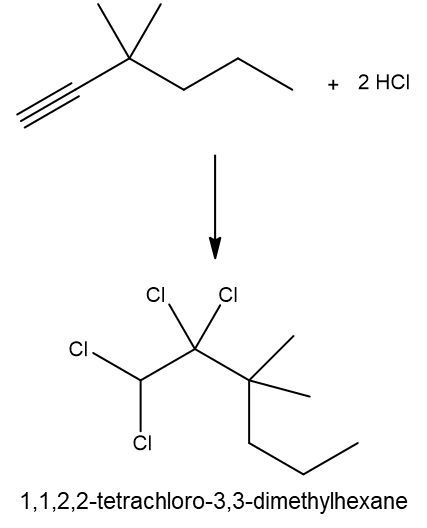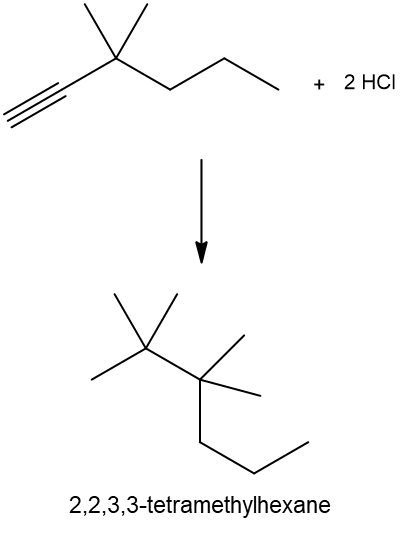In this video, we're going to take a look at hydrohalogenation reactions. So under this type of reaction, one hydrogen and one halogen, either bromine or chlorine, are added to one pi bond. Here in our general type of reaction, we have an alkene to start with, and we're reacting it with HX. Here, one hydrogen would go to one of these double-bonded carbons and the halogen to the other. Both of them are the same; it's a symmetrical molecule, both alkene carbons have the same number of hydrogens. So here you could either add the H here or here, and then you'd add the halogen to the other side. Here I choose to add them in these positions, and at the end of it, what do we just make? Well, we transitioned from an alkene reactant to an alkyl halide product. So when it comes to hydrohalogenation, we're trying to create alkyl halide products as our final answer.
- 1. Matter and Measurements4h 29m
- What is Chemistry?5m
- The Scientific Method9m
- Classification of Matter16m
- States of Matter8m
- Physical & Chemical Changes19m
- Chemical Properties8m
- Physical Properties5m
- Intensive vs. Extensive Properties13m
- Temperature (Simplified)9m
- Scientific Notation13m
- SI Units (Simplified)5m
- Metric Prefixes24m
- Significant Figures (Simplified)11m
- Significant Figures: Precision in Measurements7m
- Significant Figures: In Calculations19m
- Conversion Factors (Simplified)15m
- Dimensional Analysis22m
- Density12m
- Specific Gravity9m
- Density of Geometric Objects19m
- Density of Non-Geometric Objects9m
- 2. Atoms and the Periodic Table5h 23m
- The Atom (Simplified)9m
- Subatomic Particles (Simplified)12m
- Isotopes17m
- Ions (Simplified)22m
- Atomic Mass (Simplified)17m
- Atomic Mass (Conceptual)12m
- Periodic Table: Element Symbols6m
- Periodic Table: Classifications11m
- Periodic Table: Group Names8m
- Periodic Table: Representative Elements & Transition Metals7m
- Periodic Table: Elemental Forms (Simplified)6m
- Periodic Table: Phases (Simplified)8m
- Law of Definite Proportions9m
- Atomic Theory9m
- Rutherford Gold Foil Experiment9m
- Wavelength and Frequency (Simplified)5m
- Electromagnetic Spectrum (Simplified)11m
- Bohr Model (Simplified)9m
- Emission Spectrum (Simplified)3m
- Electronic Structure4m
- Electronic Structure: Shells5m
- Electronic Structure: Subshells4m
- Electronic Structure: Orbitals11m
- Electronic Structure: Electron Spin3m
- Electronic Structure: Number of Electrons4m
- The Electron Configuration (Simplified)22m
- Electron Arrangements5m
- The Electron Configuration: Condensed4m
- The Electron Configuration: Exceptions (Simplified)12m
- Ions and the Octet Rule9m
- Ions and the Octet Rule (Simplified)8m
- Valence Electrons of Elements (Simplified)5m
- Lewis Dot Symbols (Simplified)7m
- Periodic Trend: Metallic Character4m
- Periodic Trend: Atomic Radius (Simplified)7m
- 3. Ionic Compounds2h 18m
- Periodic Table: Main Group Element Charges12m
- Periodic Table: Transition Metal Charges6m
- Periodic Trend: Ionic Radius (Simplified)5m
- Periodic Trend: Ranking Ionic Radii8m
- Periodic Trend: Ionization Energy (Simplified)9m
- Periodic Trend: Electron Affinity (Simplified)8m
- Ionic Bonding6m
- Naming Monoatomic Cations6m
- Naming Monoatomic Anions5m
- Polyatomic Ions25m
- Naming Ionic Compounds11m
- Writing Formula Units of Ionic Compounds7m
- Naming Ionic Hydrates6m
- Naming Acids18m
- 4. Molecular Compounds2h 18m
- Covalent Bonds6m
- Naming Binary Molecular Compounds6m
- Molecular Models4m
- Bonding Preferences6m
- Lewis Dot Structures: Neutral Compounds (Simplified)8m
- Multiple Bonds4m
- Multiple Bonds (Simplified)6m
- Lewis Dot Structures: Multiple Bonds10m
- Lewis Dot Structures: Ions (Simplified)8m
- Lewis Dot Structures: Exceptions (Simplified)12m
- Resonance Structures (Simplified)5m
- Valence Shell Electron Pair Repulsion Theory (Simplified)4m
- Electron Geometry (Simplified)8m
- Molecular Geometry (Simplified)11m
- Bond Angles (Simplified)11m
- Dipole Moment (Simplified)15m
- Molecular Polarity (Simplified)7m
- 5. Classification & Balancing of Chemical Reactions3h 17m
- Chemical Reaction: Chemical Change5m
- Law of Conservation of Mass5m
- Balancing Chemical Equations (Simplified)13m
- Solubility Rules16m
- Molecular Equations18m
- Types of Chemical Reactions12m
- Complete Ionic Equations18m
- Calculate Oxidation Numbers15m
- Redox Reactions17m
- Spontaneous Redox Reactions8m
- Balancing Redox Reactions: Acidic Solutions17m
- Balancing Redox Reactions: Basic Solutions17m
- Balancing Redox Reactions (Simplified)13m
- Galvanic Cell (Simplified)16m
- 6. Chemical Reactions & Quantities2h 35m
- 7. Energy, Rate and Equilibrium3h 46m
- Nature of Energy6m
- First Law of Thermodynamics7m
- Endothermic & Exothermic Reactions7m
- Bond Energy14m
- Thermochemical Equations12m
- Heat Capacity19m
- Thermal Equilibrium (Simplified)8m
- Hess's Law23m
- Rate of Reaction11m
- Energy Diagrams12m
- Chemical Equilibrium7m
- The Equilibrium Constant14m
- Le Chatelier's Principle23m
- Solubility Product Constant (Ksp)17m
- Spontaneous Reaction10m
- Entropy (Simplified)9m
- Gibbs Free Energy (Simplified)18m
- 8. Gases, Liquids and Solids3h 25m
- Pressure Units6m
- Kinetic Molecular Theory14m
- The Ideal Gas Law18m
- The Ideal Gas Law Derivations13m
- The Ideal Gas Law Applications6m
- Chemistry Gas Laws16m
- Chemistry Gas Laws: Combined Gas Law12m
- Standard Temperature and Pressure14m
- Dalton's Law: Partial Pressure (Simplified)13m
- Gas Stoichiometry18m
- Intermolecular Forces (Simplified)19m
- Intermolecular Forces and Physical Properties11m
- Atomic, Ionic and Molecular Solids10m
- Heating and Cooling Curves30m
- 9. Solutions4h 10m
- Solutions6m
- Solubility and Intermolecular Forces18m
- Solutions: Mass Percent6m
- Percent Concentrations10m
- Molarity18m
- Osmolarity15m
- Parts per Million (ppm)13m
- Solubility: Temperature Effect8m
- Intro to Henry's Law4m
- Henry's Law Calculations12m
- Dilutions12m
- Solution Stoichiometry14m
- Electrolytes (Simplified)13m
- Equivalents11m
- Molality15m
- The Colligative Properties15m
- Boiling Point Elevation16m
- Freezing Point Depression9m
- Osmosis16m
- Osmotic Pressure9m
- 10. Acids and Bases3h 29m
- Acid-Base Introduction11m
- Arrhenius Acid and Base6m
- Bronsted Lowry Acid and Base18m
- Acid and Base Strength17m
- Ka and Kb12m
- The pH Scale19m
- Auto-Ionization9m
- pH of Strong Acids and Bases9m
- Acid-Base Equivalents14m
- Acid-Base Reactions7m
- Gas Evolution Equations (Simplified)6m
- Ionic Salts (Simplified)23m
- Buffers25m
- Henderson-Hasselbalch Equation16m
- Strong Acid Strong Base Titrations (Simplified)10m
- 11. Nuclear Chemistry56m
- BONUS: Lab Techniques and Procedures1h 38m
- BONUS: Mathematical Operations and Functions47m
- 12. Introduction to Organic Chemistry1h 34m
- 13. Alkenes, Alkynes, and Aromatic Compounds2h 12m
- 14. Compounds with Oxygen or Sulfur1h 6m
- 15. Aldehydes and Ketones1h 1m
- 16. Carboxylic Acids and Their Derivatives1h 11m
- 17. Amines38m
- 18. Amino Acids and Proteins1h 51m
- 19. Enzymes1h 37m
- 20. Carbohydrates1h 46m
- Intro to Carbohydrates4m
- Classification of Carbohydrates4m
- Fischer Projections4m
- Enantiomers vs Diastereomers8m
- D vs L Enantiomers8m
- Cyclic Hemiacetals8m
- Intro to Haworth Projections4m
- Cyclic Structures of Monosaccharides11m
- Mutarotation4m
- Reduction of Monosaccharides10m
- Oxidation of Monosaccharides7m
- Glycosidic Linkage14m
- Disaccharides7m
- Polysaccharides7m
- 21. The Generation of Biochemical Energy2h 8m
- 22. Carbohydrate Metabolism2h 22m
- 23. Lipids2h 26m
- Intro to Lipids6m
- Fatty Acids25m
- Physical Properties of Fatty Acids6m
- Waxes4m
- Triacylglycerols12m
- Triacylglycerol Reactions: Hydrogenation8m
- Triacylglycerol Reactions: Hydrolysis13m
- Triacylglycerol Reactions: Oxidation7m
- Glycerophospholipids15m
- Sphingomyelins13m
- Steroids15m
- Cell Membranes7m
- Membrane Transport10m
- 24. Lipid Metabolism1h 45m
- 25. Protein and Amino Acid Metabolism1h 37m
- 26. Nucleic Acids and Protein Synthesis2h 54m
- Intro to Nucleic Acids4m
- Nitrogenous Bases16m
- Nucleoside and Nucleotide Formation9m
- Naming Nucleosides and Nucleotides13m
- Phosphodiester Bond Formation7m
- Primary Structure of Nucleic Acids11m
- Base Pairing10m
- DNA Double Helix6m
- Intro to DNA Replication20m
- Steps of DNA Replication11m
- Types of RNA10m
- Overview of Protein Synthesis4m
- Transcription: mRNA Synthesis9m
- Processing of pre-mRNA5m
- The Genetic Code6m
- Introduction to Translation7m
- Translation: Protein Synthesis18m
Hydrohalogenation Reaction - Online Tutor, Practice Problems & Exam Prep
 Created using AI
Created using AIHydrohalogenation reactions involve the addition of hydrogen and a halogen (bromine or chlorine) to a pi bond in alkenes or alkynes, resulting in alkyl halide products. For non-symmetrical alkenes, Markovnikov's rule dictates that the hydrogen atom attaches to the carbon with more hydrogens, while the halogen attaches to the carbon with fewer hydrogens. In alkynes, two moles of HX are required, leading to the formation of dihalides. Understanding these principles is crucial for predicting product formation in organic reactions.
Hydrohalogenation Reaction Concept 1
Video transcript
Hydrohalogenation Reaction Example 1
Video transcript
Complete the following hydrohalogenation reaction. So here we have cyclopentene reacting with hydrobromic acid. Here we're going to say, we're going to break the double bond, and both of these double bonded carbons are symmetrical, so the H could go to either one, and the Br could go to the other. Here I decide to add the hydrogen here, and then the bromine will go here. In the process, we've just created an alkyl halide. Here we've created bromocyclopentane as our final product.
Markovnikov's Rule Concept 2
Video transcript
Now the addition of hydrogen and a halogen to a non-symmetrical alkene or alkyne follows Markovnikov's rule. Under Markovnikov's rule, the hydrogen atom is added to the carbon, whether it be double bonded or triple bonded, with more hydrogens. And then the addition, and then the halogen atom or X atom is added to the triple bonded or double bonded carbon with fewer hydrogens. If we take a look here, we have an alkene to start, the alkene on the left only has 1 hydrogen, and the one on the right has 2. Following Markovnikov's rule, hydrogen would go to the double bonded carbon with more hydrogens, so it'd go here, and then the halogen would go to the one with fewer hydrogens, so it'd go here. In this process, we made an Alkyl Halide. Now, when we have an Alkyne, we have 2 π bonds, so we'd need 2 moles of HX. Still following Markovnikov's Rule, hydrogen would go to the now triple bonded carbon with more hydrogens, and there'd be 2 of them adding, and then we'd have 2 halogens adding to the triple bonded carbon with fewer hydrogens. So this one here. As a result of using 2 moles of HX, we wind up with a dihalide with both halogens adding to the same formally triple bonded carbon. So just remember, we use Markovnikov's rule if our double or triple bonded carbons have a different number of hydrogens each. Use this rule to determine what your final answer will be.
Markovnikov's Rule Example 2
Video transcript
Complete the following hydrohalogenation reaction. Here we have our alkene reacting with HCl. What we do first is we look to see what kind of double bonded carbons we have. The one on the left is making 4 bonds, so it has no hydrogens. The one on the right is making 3 bonds that we see, so it has 1 hydrogen. Since the two double-bonded carbons have different numbers of hydrogens, we are going to use Markovnikov's rule to determine where the H and the Cl will go. Following Markovnikov's rule, it states that the hydrogen will go to the double-bonded carbon with more hydrogens, so it would go here. Of course, the hydrogen that was originally there is still there, and then the chlorine would go to the double bonded carbon with fewer hydrogens. So it would go here.
This will represent the alkyl halide product formed from the hydrohalogenation between our reactants. Now remember, your hydrogens when they are connected to carbon are invisible, so you could erase them, and this would be our full skeletal formula for our product.
Write a hydrohalogenation reaction with excess HCl and name the organic product formed.
Do you want more practice?
Here’s what students ask on this topic:
What is hydrohalogenation in organic chemistry?
Hydrohalogenation is a type of addition reaction in organic chemistry where a hydrogen atom (H) and a halogen atom (X, such as bromine or chlorine) are added to a carbon-carbon double bond (alkene) or triple bond (alkyne). The general reaction involves an alkene or alkyne reacting with a hydrogen halide (HX) to form an alkyl halide. For example, when ethene (C2H4) reacts with hydrogen bromide (HBr), the product is bromoethane (C2H5Br). This reaction is important for synthesizing various organic compounds.
 Created using AI
Created using AIHow does Markovnikov's rule apply to hydrohalogenation reactions?
Markovnikov's rule states that in the addition of HX to an unsymmetrical alkene, the hydrogen atom (H) will attach to the carbon with more hydrogen atoms, while the halogen (X) will attach to the carbon with fewer hydrogen atoms. This rule helps predict the major product of the reaction. For example, in the hydrohalogenation of propene (CH3-CH=CH2) with HBr, the hydrogen will add to the carbon with two hydrogen atoms (CH3-CH2-CH2Br), and the bromine will add to the carbon with fewer hydrogen atoms, resulting in 2-bromopropane as the major product.
 Created using AI
Created using AIWhat is the product of hydrohalogenation of an alkyne?
In the hydrohalogenation of an alkyne, two moles of HX are required to fully saturate the triple bond. The reaction follows Markovnikov's rule, where the hydrogen atoms add to the carbon with more hydrogen atoms, and the halogen atoms add to the carbon with fewer hydrogen atoms. For example, when acetylene (C2H2) reacts with two moles of HBr, the product is 1,1-dibromoethane (CH2Br-CH2Br). This results in a dihalide with both halogens attached to the same carbon atom.
 Created using AI
Created using AIWhat are the key differences between hydrohalogenation of alkenes and alkynes?
The key differences between hydrohalogenation of alkenes and alkynes are the number of moles of HX required and the resulting products. For alkenes, only one mole of HX is needed, and the product is an alkyl halide. For alkynes, two moles of HX are required, leading to the formation of a dihalide. Additionally, both reactions follow Markovnikov's rule, but in alkynes, the addition of two moles of HX results in both halogen atoms attaching to the same carbon atom, whereas in alkenes, only one halogen atom is added.
 Created using AI
Created using AIWhy is Markovnikov's rule important in predicting the outcome of hydrohalogenation reactions?
Markovnikov's rule is important because it helps predict the major product of hydrohalogenation reactions involving unsymmetrical alkenes or alkynes. By determining which carbon atom the hydrogen and halogen will attach to, chemists can accurately predict the structure of the final product. This rule is based on the stability of the carbocation intermediate formed during the reaction, where the more stable carbocation leads to the major product. Understanding this rule is crucial for designing and synthesizing specific organic compounds in a controlled manner.
 Created using AI
Created using AIYour GOB Chemistry tutor
- Ocimene, a compound isolated from the herb basil, has three double bonds and the IUPAC name 3,7-dimethyl-1, 3-...
- Draw all possible products formed when 2-methyl-2-butene undergoes addition with HCl. Label them as being eith...
- In the following addition reactions, are the given alkyl halides obtained as the major products? Give a reason...
- What alkene could you use to make the following products? Draw the structure of the alkene, and tell what othe...
- 1-Pentyne reacts with HBr in a 1:1 molar ratio to yield two different addition products, both being bromopente...
- Complete the following equations (Hint: Answers may include concepts learned from previous organic chapters):c...





